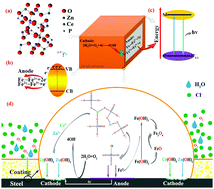Preparation and electrochemical inhibition properties of Ce3+-photomodified zinc phosphate materials
Abstract
Breakthroughs in the intrinsic properties of environmentally friendly zinc phosphate materials for corrosion protection require the realization of new structures. The zinc phosphate material was effectively modified with rare earth cerium ions by ultrasound-assisted precipitation. The crystal structure, Zn, P, and O node arrangement and band gap of the zinc phosphate material were changed, which enhanced the light absorption and brought about photogenerated electron enrichment to achieve photogenerated electron corrosion protection. The modified material generates fluorescence at 515 nm, and the consumption of fluorescence energy brings about the reduction of electrode reaction activity and the inhibition of electrode reaction. The inhibition mechanism was experimentally confirmed. In addition, the cerium ion modification changed the crystal micromorphology of ZP, and the lamellar structure of zinc phosphate evolved into a composite structure enriched with flakes and small particles, and the synergistic effect of particles and lamellar structure promoted the improvement of corrosion resistance. The impedance value of the modified ZP anticorrosive pigment was increased by 44.13%, which effectively reduced the amount of anticorrosive pigment and the cost of industrial application.



 Please wait while we load your content...
Please wait while we load your content...